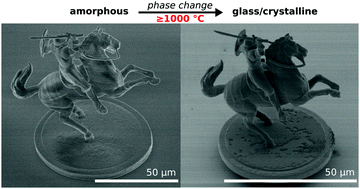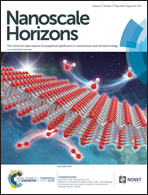Abstract
Fabrication of a true-3D inorganic ceramic with resolution down to the nanoscale (∼100 nm) using a sol–gel resist precursor is demonstrated. This method has an unrestricted free-form capability, control of the fill-factor, and high fabrication throughput. A systematic study of the proposed approach based on ultrafast laser 3D lithography of organic–inorganic hybrid sol–gel resin followed by a heat treatment enabled the formation of inorganic amorphous and crystalline composites guided by the composition of the initial resin. The achieved resolution of 100 nm was obtained for 3D patterns of complex free-form architectures. Fabrication throughput of 50 × 103 voxels per second is achieved; voxel – a single volume element recorded by a single pulse exposure. A post-exposure thermal treatment was used to form a ceramic phase, the composition and structure of which were dependent on the temperature and duration of the heat treatment as revealed by Raman micro-spectroscopy. The X-ray diffraction (XRD) showed a gradual emergence of the crystalline phases at higher temperatures with a signature of cristobalite SiO2, a high-temperature polymorph. Also, a tetragonal ZrO2 phase known for its high fracture strength was observed. This 3D nano-sintering technique is scalable from nanoscale to millimeter dimensions and opens a conceptually novel route for optical 3D nano-printing of various crystalline inorganic materials defined by an initial composition for diverse applications for microdevices designed to function in harsh physical and chemical environments and at high temperatures.

- This article is part of the themed collection: Winners of the 2019 Horizons Outstanding Paper awards


 Please wait while we load your content...
Please wait while we load your content...